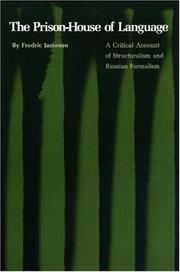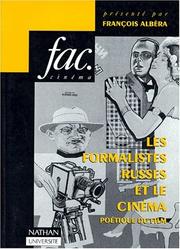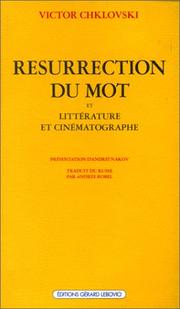| Listing 1 - 4 of 4 |
Sort by
|

ISBN: 0691013160 9780691013169 0691062269 069121431X Year: 1974 Publisher: Princeton, N.J. : Princeton University Press,
Abstract | Keywords | Export | Availability | Bookmark
 Loading...
Loading...Choose an application
- Reference Manager
- EndNote
- RefWorks (Direct export to RefWorks)
Surveys and contrasts the basic concepts, structures, and methods of the two modern linguistic movements.
Russisch formalisme. --- letterkunde. --- Structuralisme --- Taalfilosofie. --- Linguistique structurale --- Structuralisme (littérature) --- Formalisme (analyse littéraire)

ISBN: 2091907812 9782091907819 Year: 1996 Publisher: Paris: Fernand Nathan,
Abstract | Keywords | Export | Availability | Bookmark
 Loading...
Loading...Choose an application
- Reference Manager
- EndNote
- RefWorks (Direct export to RefWorks)
Formalisme (analyse littéraire) --- Cinéma russe --- Cinéma --- Formalisme (analyse filmique) --- Cinéma et littérature --- Esthétique --- Dans la littérature --- Formalisme (littérature) --- Formalisme (cinéma) --- Dans la littérature. --- Cinéma russe. --- Cinéma et littérature. --- Esthétique. --- Cinéma russe. --- Cinéma --- Dans la littérature.

ISBN: 2851841599 Year: 1985 Publisher: Paris Editions Gérard Lebovici
Abstract | Keywords | Export | Availability | Bookmark
 Loading...
Loading...Choose an application
- Reference Manager
- EndNote
- RefWorks (Direct export to RefWorks)
Formalisme (analyse littéraire) --- Poétique --- Art et littérature --- Cinéma et littérature --- Formalism (Literary analysis) --- Poetics --- Art and literature. --- Motion pictures and literature. --- Histoire --- History --- Formalisme (littérature) --- Art et littérature. --- Cinéma et littérature. --- Formalisme (littérature) --- Poétique --- Art et littérature. --- Cinéma et littérature.
Book
ISBN: 9780822356448 9780822356561 0822356449 0822356562 0822376776 Year: 2014 Publisher: Durham : Duke University Press,
Abstract | Keywords | Export | Availability | Bookmark
 Loading...
Loading...Choose an application
- Reference Manager
- EndNote
- RefWorks (Direct export to RefWorks)
What is the relationship between a cinematic grid of color and that most visceral of negative affects, disgust? How might anxiety be a matter of an interrupted horizontal line, or grief a figure of blazing light?Offering a bold corrective to the emphasis on embodiment and experience in recent affect theory, Eugenie Brinkema develops a novel mode of criticism that locates the forms of particular affects within the specific details of cinematic and textual construction. Through close readings of works by Roland Barthes, Hollis Frampton, Sigmund Freud, Peter Greenaway, Michael Haneke, Alfred Hitchcock, Søren Kierkegaard, and David Lynch, Brinkema shows that deep attention to form, structure, and aesthetics enables a fundamental rethinking of the study of sensation. In the process, she delves into concepts as diverse as putrescence in French gastronomy, the role of the tear in philosophies of emotion, Nietzschean joy as a wild aesthetic of repetition, and the psychoanalytic theory of embarrassment. Above all, this provocative work is a call to harness the vitality of the affective turn for a renewed exploration of the possibilities of cinematic form.
Critiques de cinéma --- Formalisme (analyse littéraire) --- Affect (psychologie) --- Film criticism. --- Formalism (Literary analysis) --- Affect (Psychology) --- Critical theory. --- #SBIB:309H520 --- #SBIB:39A8 --- Critical social theory --- Critical theory (Philosophy) --- Critical theory (Sociology) --- Negative philosophy --- Criticism (Philosophy) --- Philosophy, Modern --- Rationalism --- Sociology --- Frankfurt school of sociology --- Socialism --- Emotions --- Psychology --- Formalism (Russian literature) --- Russian formalism (Literary analysis) --- Criticism --- Motion picture criticism --- Motion pictures --- Moving-picture criticism --- Audiovisuele communicatie: algemene werken --- Antropologie: linguïstiek, audiovisuele cultuur, antropologie van media en representatie --- Evaluation --- Formalism (Literary analysis). --- Affect (Psychology). --- Formalisme (littérature) --- Critical theory --- Film criticism --- Critiques de cinéma. --- Critiques de cinéma. --- Formalisme (littérature)
| Listing 1 - 4 of 4 |
Sort by
|

 Search
Search Feedback
Feedback About UniCat
About UniCat  Help
Help News
News